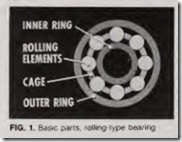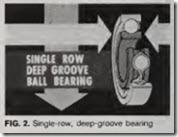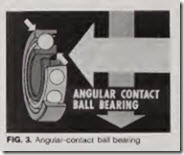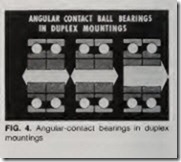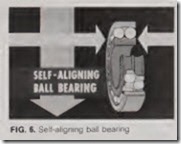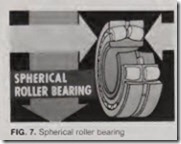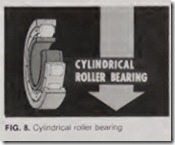Know bearing basics for longer motor life
By RAYMOND A. GUYER, JR.
ROLLING-TYPE BEARINGS are clas sified into two basic families-ball and roller. Each family includes a variety of bearing designs, depending on speed required, operating temperature, and the kind of working load to be encoun tered. Sleeve bearings, special bear ings, and custom designs have many applications; however, rolling-type bearings are used extensively in elec tric motors.
Ball bearings are found in practical ly any type or size of motor. They offer low friction, can operate at high speed, and run effectively over a wide temperature range. Modern ball bearings are well designed for the job at hand, are made of increasingly better materials, and last longer. Fig. 1 shows the basic parts of a rolling-type bearing.
In the ball-bearing family, the most popular assembly is the single-row deep-groove bearing (Fig. 2). It is a radial-load bearing, but it can also handle considerable thrust loads in either axial direction. (A thrust load is a pushing force against the bearing parallel to the shaft; radial load is a pressing force at right angles to the shaft. Most bearings are expected to carry both types of loads to some degree.)
The angular-contact ball bearing supports a heavy thrust load in one direction, sometimes combined with a moderate radial load (Fig. 3). The stan dard type can be used when the bearing is mounted singly. Modified types are used in duplex mountings for all com binations of thrust and radial loads (see Fig. 4). The sides of the bearings are universally flush-ground, permit ting them to be installed in any way needed to do the job required. The preloaded type is mounted to handle the same load conditions as modified bearings, but it has a built-in factory preload. Preloaded bearings have an identification letter followed by a num ber that indicates the preload. Pre loaded bearings should always be replaced with those having the same preload. Markings used by different manufacturers will vary.
Preloading refers to a bearing that has no axial or radial clearance. Radial clearance is the distance the inner and outer rings of a bearing can move radi ally in relation to each other when the bearing is unmounted. Axial clearance is the distance that the inner and outer race can move parallel to the shaft. There is virtually no internal move ment in a mounted preloaded bearing. Some bearings have special radial clearance. The higher the operating temperature, the greater the internal radial clearance should be. Since the bearing inner ring will expand more than the outer ring under high temper ature use, a high radial clearance allows for heat expansion. To achieve maximum bearing life, bearings having special clearance designations should always be replaced by bearings with identical designtions.
The double-row deep-groove ball bearing (Fig. 5) will sustain considera ble radial loads because of the two rows of balls. It can handle moderate thrust load in either axial direction as well. Its capability is about 1.5 times that of a single-row bearing.
The self-aligning ball bearing (Fig.
6) has two rows of balls rolling on a spherical surface of the outer ring. This arrangement compensates for angular misalignment resulting from errors in mounting, shaft deflection, and distortion of the foundation . It is impossible for this bearing to exert any bending influence on the shaft, a most important consideration in applica tions requiring extreme accuracy at high speeds. Self-aligning ball bearings are used for radial loads and moderate thrust loads in either direction.
Ball bearings are available open or with seals and/or shields. These are designed to keep dirt and abrasives out of the bearing and keep lubricant inside. When a bearing is equipped with a seal, shield, or both, its outer dimensions do not change. It can fit within the same boundaries as an open or unprotected bearing. The shield alone is suitable for many applications. It keeps larger dirt particles out of the bearing raceways. Where dust and abrasives are present, a seal can be used. This seal is a stamped metal plate similar to a shield but with a rubber fabric washer attached to the inner surface. The washer lip rides on the seal groove of the inner ring. There are bearings that have a seal on one side and a shield on the other side, or only one seal or one shield. Some bear ings have two shields or two seals.
Bearing numbers have a very impor tant meaning for ball bearings. One manufacturer’s system is typical of bearing identification methods. Th e first number indicates the manufactur er’s series. The second gives the section height or outer diameter for a given size of bore. The last number, when multiplied by five, gives the size of the bore in millimeters. This is true for a 20- through 480-mm bore bearing. For example, a bearing is marked with the number “6210.” The 6 indicates the bearing series (single-row, deep-groove ball); the 2 shows the diameter series; and 10 X 5 equals 50 mm, the bore size. More details on bearing number ing systems can be obtained from bear ing manufacturers’ catalogs.
Roll er bearings are encountered in some large motors and in various portions of a drive train.
The spherical roller bearing (Fig. 7) uses two rows of barrel-shaped rollers.
They allow the bearing to compensate for slight misalignment of the shaft. Although it is a very rugged radial bearing, the spherical roller bearing can also carry considerab l e thrust loads in either direction.
The cylindrical roller bearing (Fig.8) has a high radial load capacity in relation to its size. It is a low-friction bearing that is excellent for high-speed operation. A double-row cylindrical roller bearing is made with extra precise tolerances.
The tapered roller bearing (Fig. 9) carries almost equal radial and thrust loads. It consists of an inner ring, called the cone, the rollers and their cage, and the outer ring, called the cup. This type of bearing should not be mounted on a shaft by itself, since the radial load induces a thrust load. To counterbalance the thrust load, a sec ond tapered roll er bearing is required.
A lso available is the spherical roller thrust bearing (Fig. 10), which is spe cifically designed for extra-heavy thrust loads in one direction. It is inherently self-aligning , providing long life. Typical applications include on hollow-shaft vert ical motors used in deep wells and for power-plant cooling water.
Bearings should always be replaced with their exact equi valents. Factors such as load, speed, operating tempera ture, environment, and life expectancy should be carefully checked to make sure replacement bearings are identical to the originals in all these respects. For any repeating bearing problems, a local distributor or the bearing manu facturer should be contacted for a thor ough hearing review.
